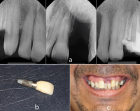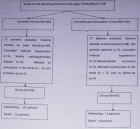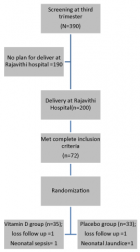Abstract
Opinion
Zoonotic potential of Giardia lamblia and control of giardiasis
Maria Fantinatti*
Published: 07 February, 2019 | Volume 3 - Issue 1 | Pages: 001-004
Giardia is the most common pathogenic intestinal flagellate protozoan in the world. The most studied species is Giardia lamblia (syn. Giardia intestinalis, Giardia duodenalis) that infects mammals, including humans. About the other seven species the scientific literature is very scarce and little is known about its characteristics and epidemiological importance. The exception is Giardia muris species that is frequently used in experimental infection to attempt to understand the parasite-host interaction in G. lamblia infection [1].
Read Full Article HTML DOI: 10.29328/journal.ivs.1001013 Cite this Article Read Full Article PDF
References
- Cacciò SM, Lalle M, Svärd SG. Host specificity in the Giardia duodenalis species complex. Infect Genet Evol. 2018; 66: 335-345. Ref.: https://goo.gl/w7jr26
- Monis PT, Andrews RH, Mayrhofer G, Ey PL. Molecular systematics of the parasitic protozoan Giardia intestinalis. Mol Biol Evol. 1999; 16: 1135-1144. Ref.: https://goo.gl/U9C2mg
- Thompson RC, Hopkins RM, Homan WL. Nomenclature and genetic groupings of Giardia infecting mammals. Parasitol Today. 2000; 16: 210-213. Ref.: https://goo.gl/Jhp37e
- Adam RD. Biology of Giardia lamblia. Clin Microbiol Rev. 2001; 14: 447-475. Ref.: https://goo.gl/U37gnN
- Feng Y, Xiao L. Zoonotic potential and molecular epidemiology of Giardia species and giardiasis. Clin Microbiol Rev. 2011; 24: 110-140. Ref.: https://goo.gl/iMWzi7
- Palmer CS, Traub RJ, Robertson ID, Devlin G, Rees R, et al. Determining the zoonotic significance of Giardia and Cryptosporidium in Australian dogs and cats. Vet. Parasitol. 2008; 154: 142-147. Ref.: https://goo.gl/nKavAa
- Read CM, Monis PT, Thompson RC. Discrimination of all genotypes of Giardia duodenalis at the glutamate dehydrogenase locus using PCR-RFLP. Infect Genet Evol. 2004; 4: 125-130. Ref.: https://goo.gl/ubF76T
- Traub RJ, Inpankaew T, Reid SA, Sutthikornchai C, Sukthana Y, et al. Transmission cycles of Giardia duodenalis in dogs and humans in Temple communities in Bangkok--a critical evaluation of its prevalence using three diagnostic tests in the field in the absence of a gold standard. Acta Trop. 2009; 111: 125-132. Ref.: https://goo.gl/TwXpZj
- Qi M, Xi J, Li J, Wang H, Ning C, et al. Prevalence of Zoonotic Giardia duodenalis Assemblage B and First Identification of Assemblage E in Rabbit Fecal Samples Isolates from Central China. J Eukaryot Microbiol. 2015; 62: 810-814. Ref.: https://goo.gl/9U12xU
- Du SZ, Zhao GH, Shao JF, Fang YQ, Tian GR, et al. Cryptosporidiumspp, Giardia intestinalis, and Enterocytozoonbieneusi in captive non-human primates in Qinling Mountains. Korean J Parasitol. 2015; 53: 395-402. Ref.: https://goo.gl/ncRDh3
- Lebbad M, Mattsson JG, Christensson B, Ljungström B, Backhans A, et al. From mouse to moose: multilocus genotyping of Giardia isolates from various animal species. Vet Parasitol. 2010; 168: 231-239. Ref.: https://goo.gl/4ZSJUC
- Fantinatti M, Bello AR, Fernandes O, Da-Cruz AM. Identification of Giardia lamblia assemblage E in humans points to a new anthropozoonotic cycle. J Infect Dis. 2016; 214: 1256-1259. Ref.: https://goo.gl/E5v1G1
- Armson A, Yang R, Thompson J, Johnson J, Reid S, et al. Giardia genotypes in pigs in Western Australia: prevalence and association with diarrhea. Exp Parasitol. 2009; 121: 381-383. Ref.: https://goo.gl/B3aW5u
- Cardona GA, de Lucio A, Bailo B, Cano L, de Fuentes I2, et al. Unexpected finding of feline-specific Giardia duodenalisassemblage F and Cryptosporidium felis in asymptomatic adult cattle in Northern Spain. Vet Parasitol.2015; 209:258-263. Ref.: https://goo.gl/pL9qvC
- Carranza PG, Lujan HD. New insights regarding the biology of Giardia lamblia. Microbes Infect. 2010; 12: 71-80. Ref.: https://goo.gl/CRL7NG
- Travaillé E, La Carbona S, Aubert D, Guyot K, Gargala G, et al. Development of qRT-PCR method to assess viability of Giardia intestinalis cysts, and Cryptosporidium spp. and Toxoplasma gondii oocysts. Food Control. 2016; 59: 359-365. Ref.: https://goo.gl/Y2vGaN
- Baldursson S, Karanis P. Waterborne transmission of protozoan parasites: review of worldwide outbreaks - an update 2004-2010. Water Res. 2011; 45: 6603-6614. Ref.: https://goo.gl/kMGYxx
- Hawash Y. DNA extraction from protozoan oocysts/cysts in feces for diagnostic PCR. Korean J Parasitol. 2014; 52: 263-271. Ref.: https://goo.gl/7Cyy19
- Vidal AM, Catapani WR. Enzyme-linked immunosorbent assay (ELISA) immunoassaying versus microscopy: advantages and drawbacks for diagnosing giardiasis. Sao Paulo Med J. 2005; 123: 282-285. Ref.: https://goo.gl/MEgXcT
- Schuurman T, Lankamp P, van Belkum A, Kooistra-Smid M, van Zwet A. Comparison of microscopy, real-time PCR and a rapid immunoassay for the detection of Giardia lamblia in human stool specimens. Clin Microbiol Infect. 2007; 13: 1186-1191. Ref.: https://goo.gl/T63z7j
- Calderaro A, Gorrini C, Montecchini S, Peruzzi S, Piccolo G, et a. Evaluation of a real-time polymerase chain reaction assay for the laboratory diagnosis of giardiasis. Diagn Microbiol Infect Dis. 2010; 66: 261-267. Ref.: https://goo.gl/DFb8sp
- Elsafi SH, Al-Maqati TN, Hussein MI, Adam AA, Hassan MM, et al. Comparison of microscopy, rapid immunoassay, and molecular techniques for the detection of Giardia lamblia and Cryptosporidium parvum. Parasitol Res. 2013; 112: 1641-1646. Ref.: https://goo.gl/7oL3JX
- Geurden T, Vercruysse J, Claerebout E. Is Giardia a significant pathogen in production animals? Exp Parasitol. 2010; 124:98-106. Ref.: https://goo.gl/g4eBFQ
- Walsh F. Human-animal bonds I: the relational significance of companion animals. Fam Process. 2009; 48: 462–480. Ref.: https://goo.gl/mL2HXq
- Lalle M, Jimenez-Cardosa E, Cacciò SM, Pozio E. Genotyping of Giardia duodenalis from human and animal samples from Brazil using beta-giardin gene: a phylogenetic analysis. Acta Trop. 2007; 102: 10-19. Ref.: https://goo.gl/Ej5tRQ
- Fantinatti M, Caseca AC, Bello AR, Fernandes O, Da-Cruz AM. The presence of Giardia lamblia assemblage A in dogs suggests an anthropozoonotic cycle of the parasite in Rio de Janeiro, Brazil. Infect Genet Evol. 2018; 65: 265-269. Ref.: https://goo.gl/633k1t
- Ey PL, Bruderer T, Wehrli C, Köhler P. Comparison of genetic groups determined by molecular and immunological analyses of Giardia isolated from animals and humans in Switzerland and Australia. Parasitol Res.1996; 82: 52-60. Ref.: https://goo.gl/2rB3c7
- Hopkins RM, Meloni BP, Groth DM, Wetherall JD, Reynoldson JA, et al. Ribosomal RNA sequencing reveals differences between the genotypes of Giardia isolates recovered from humans and dogs living in the same locality. J Parasitol.1997; 83: 44-51. Ref.: https://goo.gl/qPZKF8
- Lasek-Nesselquist E, Welch DM, Sogin ML. The identification of a new Giardia duodenalis assemblage in marine vertebrates and a preliminary analysis of G. duodenalis population biology in marine systems. Int J Parasitol. 2010; 40: 1063-1074. Ref.: https://goo.gl/ZE5zMS
- Monis PT, Andrews RH, Mayrhofer G, Mackrill J, Kulda J, et al. Novel lineages of Giardia intestinalis identified by genetic analysis of organisms isolated from dogs in Australia. Parasitology.1998; 116: 7-19. Ref.: https://goo.gl/J5VbSj
Similar Articles
-
Exploring novel medical applications for commonly used veterinary drug (tilmicosin antibiotic)Fatma I Abo El-Ela*,El-Banna HA. Exploring novel medical applications for commonly used veterinary drug (tilmicosin antibiotic). . 2017 doi: 10.29328/journal.ivs.1001001; 1: 001-016
-
Investigation on Theileria lestoquardi infection among sheep and goats in Nyala, South Darfur State, SudanOsman TM,Ali AM*,Hussein MO,El Ghali A,Salih DA. Investigation on Theileria lestoquardi infection among sheep and goats in Nyala, South Darfur State, Sudan. . 2017 doi: 10.29328/journal.ivs.1001002; 1: 017-023
-
Mechanism-related Teratogenic, Hormone Modulant and other Toxicological effects of Veterinary and agricultural surfactantsAndrás Székács*. Mechanism-related Teratogenic, Hormone Modulant and other Toxicological effects of Veterinary and agricultural surfactants. . 2017 doi: 10.29328/journal.ivs.1001003; 1: 024-031
-
Efficacies of 11% Lactoferricin and 0.05% Chlorhexidine Otological Solution compared, in the treatment of microbial otic overgrowth: A randomized single blinded studyLuisa Cornegliani*,Federico Leone,Francesco Albanese,Mauro Bigliati,Natalia Fanton,Antonella Vercelli. Efficacies of 11% Lactoferricin and 0.05% Chlorhexidine Otological Solution compared, in the treatment of microbial otic overgrowth: A randomized single blinded study. . 2017 doi: 10.29328/journal.ivs.1001004; 1: 032-041
-
Ocular surface Rose Bengal staining in normal dogs and dogs with Keratoconjunctivitis Sicca: Preliminary findingsWilliams DL*,Griffiths A. Ocular surface Rose Bengal staining in normal dogs and dogs with Keratoconjunctivitis Sicca: Preliminary findings. . 2017 doi: 10.29328/journal.ivs.1001005; 1: 042-046
-
Influence of Vitamin E on the Disposition Kinetics of Florfenicol after single and multiple oral administrations in Broiler ChickensFatma Ibrahim Abo El-Ela*,Hossny Awad El-Banna,Manal B El-Deen,Tohamy MA. Influence of Vitamin E on the Disposition Kinetics of Florfenicol after single and multiple oral administrations in Broiler Chickens. . 2017 doi: 10.29328/journal.ivs.1001006; 1: 047-057
-
Effects of carazolol on electrocadiographic and trace element status in sheepsRemzi Gonul,Lora Koenhemsı,Handan Aydın Vural*,Tevfik Gulyasar,Hasret Demırcan Yardıbı,Erman OR,Bora Barutcu. Effects of carazolol on electrocadiographic and trace element status in sheeps. . 2018 doi: 10.29328/journal.ivs.1001007; 2: 001-004
-
Livestock insurance a tool to reduce economical loss of farmers from climate change related HazardsAnanta Koirala*,Priyanka Bhandari. Livestock insurance a tool to reduce economical loss of farmers from climate change related Hazards. . 2018 doi: 10.29328/journal.ivs.1001008; 2: 005-008
-
The failure to provide an effective veterinary service to sheep in AustraliaJAL Maxwell*. The failure to provide an effective veterinary service to sheep in Australia. . 2018 doi: 10.29328/journal.ivs.1001009; 2: 009-017
-
Does Veterinary Science have a future in Australia?JAL Maxwell*. Does Veterinary Science have a future in Australia?. . 2018 doi: 10.29328/journal.ivs.1001010; 2: 018-026
Recently Viewed
-
A Resurgence of the Idea of Hypertriglyceridemia and Lower Serum (HDL-C) as Predictive Factors for Insulin Resistance (IR) & Type 2 Diabetes Mellitus Development: A Narrative ReviewKulvinder Kochar Kaur*. A Resurgence of the Idea of Hypertriglyceridemia and Lower Serum (HDL-C) as Predictive Factors for Insulin Resistance (IR) & Type 2 Diabetes Mellitus Development: A Narrative Review. New Insights Obes Gene Beyond. 2025: doi: 10.29328/journal.niogb.1001022; 9: 001-012
-
Novel Mutation in Famous Gene Diseases in Red Blood CellsMahdi Nowroozi*. Novel Mutation in Famous Gene Diseases in Red Blood Cells. New Insights Obes Gene Beyond. 2025: doi: 10.29328/journal.niogb.1001023; 9: 013-020
-
Physical Performance in the Overweight/Obesity Children Evaluation and RehabilitationCristina Popescu, Mircea-Sebastian Șerbănescu, Gigi Calin*, Magdalena Rodica Trăistaru. Physical Performance in the Overweight/Obesity Children Evaluation and Rehabilitation. Ann Clin Endocrinol Metabol. 2024: doi: 10.29328/journal.acem.1001030; 8: 004-012
-
The Role of Genetic Mutations in the HPGD & SLCO2A1 Genes in Pachydermoperiostosis SyndromeShahin Asadi*,Arezo Zare,Sima Koohestani. The Role of Genetic Mutations in the HPGD & SLCO2A1 Genes in Pachydermoperiostosis Syndrome. J Genet Med Gene Ther. 2025: doi: 10.29328/journal.jgmgt.1001013; 8: 001-005
-
Estimation of Radiation Dose to Blood Vessels and Components from Medical Imaging Procedures: Current StatusKhalid M Aloufi*. Estimation of Radiation Dose to Blood Vessels and Components from Medical Imaging Procedures: Current Status. Arch Vas Med. 2025: doi: 10.29328/journal.avm.1001020; 9: 001-002
Most Viewed
-
Causal Link between Human Blood Metabolites and Asthma: An Investigation Using Mendelian RandomizationYong-Qing Zhu, Xiao-Yan Meng, Jing-Hua Yang*. Causal Link between Human Blood Metabolites and Asthma: An Investigation Using Mendelian Randomization. Arch Asthma Allergy Immunol. 2023 doi: 10.29328/journal.aaai.1001032; 7: 012-022
-
Impact of Latex Sensitization on Asthma and Rhinitis Progression: A Study at Abidjan-Cocody University Hospital - Côte d’Ivoire (Progression of Asthma and Rhinitis related to Latex Sensitization)Dasse Sery Romuald*, KL Siransy, N Koffi, RO Yeboah, EK Nguessan, HA Adou, VP Goran-Kouacou, AU Assi, JY Seri, S Moussa, D Oura, CL Memel, H Koya, E Atoukoula. Impact of Latex Sensitization on Asthma and Rhinitis Progression: A Study at Abidjan-Cocody University Hospital - Côte d’Ivoire (Progression of Asthma and Rhinitis related to Latex Sensitization). Arch Asthma Allergy Immunol. 2024 doi: 10.29328/journal.aaai.1001035; 8: 007-012
-
An algorithm to safely manage oral food challenge in an office-based setting for children with multiple food allergiesNathalie Cottel,Aïcha Dieme,Véronique Orcel,Yannick Chantran,Mélisande Bourgoin-Heck,Jocelyne Just. An algorithm to safely manage oral food challenge in an office-based setting for children with multiple food allergies. Arch Asthma Allergy Immunol. 2021 doi: 10.29328/journal.aaai.1001027; 5: 030-037
-
Snow white: an allergic girl?Oreste Vittore Brenna*. Snow white: an allergic girl?. Arch Asthma Allergy Immunol. 2022 doi: 10.29328/journal.aaai.1001029; 6: 001-002
-
Cytokine intoxication as a model of cell apoptosis and predict of schizophrenia - like affective disordersElena Viktorovna Drozdova*. Cytokine intoxication as a model of cell apoptosis and predict of schizophrenia - like affective disorders. Arch Asthma Allergy Immunol. 2021 doi: 10.29328/journal.aaai.1001028; 5: 038-040

If you are already a member of our network and need to keep track of any developments regarding a question you have already submitted, click "take me to my Query."



















































































































































